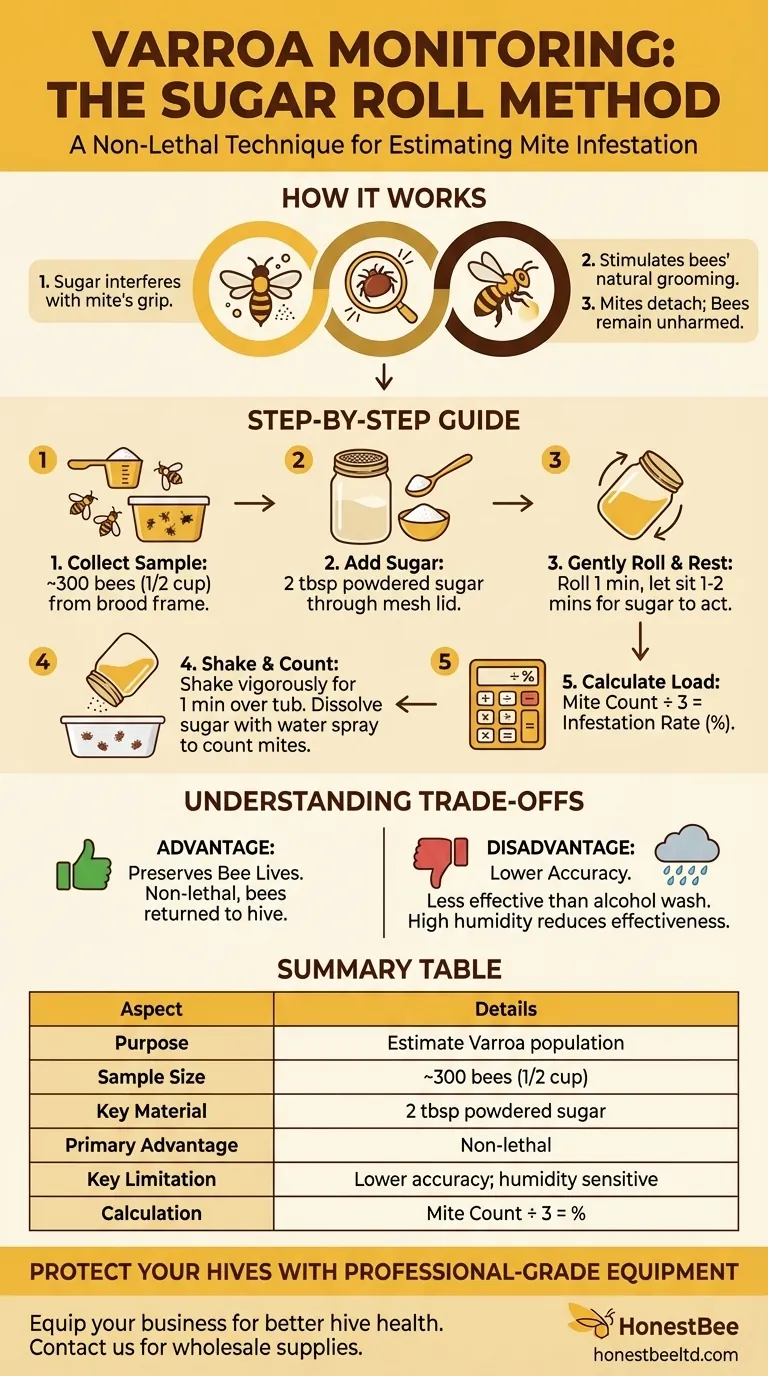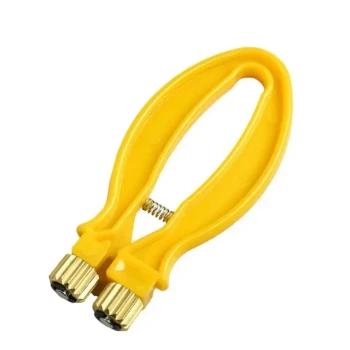The sugar roll method is a non-lethal technique used by beekeepers to estimate the number of Varroa destructor mites in a honey bee colony. It works by using powdered sugar to physically dislodge mites from a sample of bees, allowing them to be separated and counted without harming the bees themselves.
The core value of the sugar roll is its ability to provide a reasonable estimate of your hive's mite load without sacrificing bees. However, its effectiveness is highly dependent on proper technique and environmental conditions, making it slightly less accurate than the definitive alcohol wash method.

The Principle Behind the Sugar Roll
Understanding how the sugar roll functions is key to performing it correctly. The method relies on a simple physical interaction between the sugar, the mites, and the bees.
How Sugar Dislodges Mites
The fine particles of powdered sugar have two primary effects. First, they are believed to interfere with the mite's ability to grip the bee, irritating the suction-cup-like pads on their feet (the empodia) and causing them to detach.
Second, the sugar coating stimulates the bees' natural grooming behavior, which further helps to dislodge any clinging mites.
Why It's a Non-Lethal Approach
Unlike an alcohol wash, where the bee sample is killed in the process, the sugar roll is designed to be gentle. After the mites are shaken out, the sugar-coated bees can be returned to the entrance of the hive, where their sisters will clean them off and allow them to rejoin the colony.
Step-by-Step Guide to the Sugar Roll
Executing the test with a consistent technique is crucial for achieving reliable results. You will need a jar with a mesh lid (1/8-inch hardware cloth), powdered sugar, a measuring cup, and a light-colored tub or tray.
Step 1: Collect Your Bee Sample
The goal is to get a sample of approximately 300 bees, which is equivalent to a level 1/2 cup.
Carefully remove a frame from the brood chamber that has both open and capped brood. Ensure the queen is not on this frame. Gently shake the bees from the frame into your tub and scoop up your 1/2 cup sample.
Step 2: Add the Powdered Sugar
Place the bees into your testing jar and securely fasten the mesh lid. Add two tablespoons of powdered sugar through the mesh onto the bees.
Step 3: Gently Roll and Rest
Gently roll the jar for about one minute to ensure all the bees are thoroughly coated in sugar. Avoid shaking it violently, which can harm the bees.
After rolling, let the jar sit for one to two minutes. This waiting period allows the sugar to work and gives the bees time to groom, dislodging more mites.
Step 4: Shake and Count
Turn the jar upside down and shake it vigorously over your light-colored tub for at least one minute. The sugar and the dislodged mites will fall through the mesh screen.
To make the dark mites easier to see against the white sugar, you can lightly spray the powder with water, which will dissolve the sugar and leave only the mites behind. Count every mite you see.
Step 5: Calculate Your Mite Load
To determine your infestation level, divide the number of mites you counted by the number of bees in your sample (300) and multiply by 100.
An easy shortcut is to simply divide the mite count by 3. For example, if you counted 9 mites, your infestation rate is 3% (9 mites / 3 = 3).
Understanding the Trade-offs
No monitoring method is perfect. Choosing the right one means understanding its specific advantages and limitations for your beekeeping operation.
Advantage: Preserving Bee Lives
The primary benefit of the sugar roll is that it does not require you to sacrifice any bees. This is a significant factor for beekeepers who prefer a gentler approach to hive management or who are working with smaller colonies.
Disadvantage: Lower Accuracy
The sugar roll is consistently found to be less effective than the alcohol wash. Not all mites will be dislodged, meaning this method tends to underestimate the true mite population within the hive.
The Impact of Environment
This method's effectiveness can be compromised by high humidity. When the air is damp, powdered sugar can clump together, reducing its ability to coat the bees and dislodge mites, leading to an inaccurate, artificially low count.
Making the Right Choice for Your Monitoring
Your goal for monitoring should dictate your choice of method. Both the sugar roll and alcohol wash are valuable tools when used in the correct context.
- If your primary focus is preserving every bee: The sugar roll is your best choice for routine monitoring, but be diligent about using consistent technique and testing regularly.
- If your primary focus is maximum accuracy before treatment: The alcohol wash provides a more definitive count, which is critical for making an informed and timely treatment decision.
Ultimately, consistent and regular monitoring is the most important factor in protecting your bees from the threat of Varroa mites.
Summary Table:
| Aspect | Sugar Roll Method |
|---|---|
| Purpose | Estimate Varroa mite population in a hive |
| Sample Size | ~300 bees (1/2 cup) |
| Key Material | 2 tablespoons of powdered sugar |
| Primary Advantage | Non-lethal; bees can be returned to the hive |
| Key Limitation | Lower accuracy than alcohol wash; sensitive to humidity |
| Infestation Rate Calculation | Mite Count ÷ 3 = Percentage (%) |
Protect Your Hives with Professional-Grade Equipment
Consistent and accurate monitoring is the first step to healthy colonies. For commercial apiaries and distributors, having reliable, high-quality equipment is essential for effective hive management.
HONESTBEE supplies the durable beekeeping supplies and equipment you need to perform monitoring tests like the sugar roll method with confidence. From testing jars to protective gear, we support your operation's success through our wholesale-focused services.
Ready to equip your business for better hive health? Contact HONESTBEE today to discuss your wholesale needs and discover how our products can contribute to the vitality of your bees and the success of your operation.
Visual Guide

Related Products
- Varroa Easy Check Mite Tester Kit Counter Alcohol Wash Jar
- HONESTBEE Classic Pry Bar Hive Tool with High Visibility Finish for Beekeeping
- Multi-Function Hive Tool with Integrated Hammer for Beekeeping
- Professional Galvanized Hive Strap with Secure Locking Buckle for Beekeeping
- Professional Grade Foldable Beehive Handles
People Also Ask
- What is the most accurate method for monitoring varroa mites? The Definitive Guide for Beekeepers
- How often should varroa mite checks be performed using the alcohol wash method? Optimize Your Apiary's Health
- How is the infestation percentage calculated after counting mites? Master Varroa Mite Monitoring
- Why is an alcohol wash preferred over powdered sugar rolls? For Accurate Varroa Mite Management
- What are some popular methods to measure Varroa mite load in beehives? Compare Accuracy & Bee Safety



















